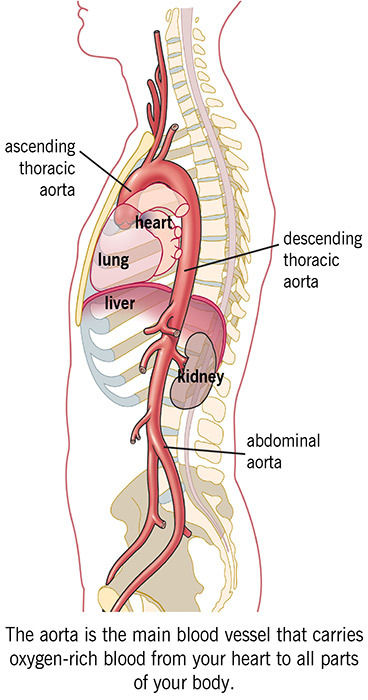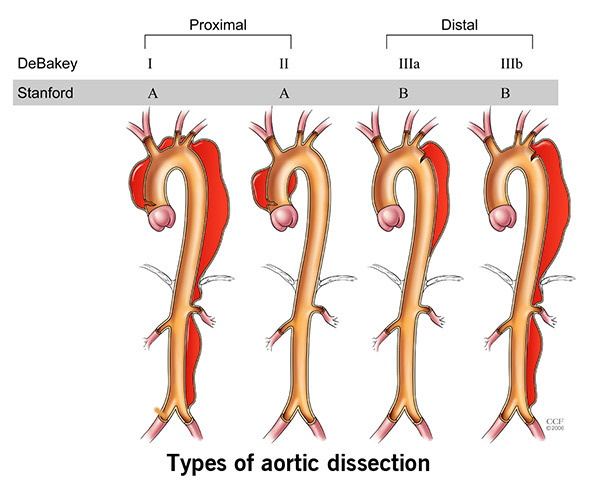What is aortic dissection?

Your aorta is the large artery connected to the left lower chamber (ventricle) of your heart. It is the main blood vessel that carries oxygen-rich blood to all parts of your body. The aorta has three layers. It is possible for the inner layer to tear. When this happens, the aorta bleeds into itself through the middle layer. This causes the tear to get bigger, and the layers of the aorta separate. This is called aortic dissection.
What causes aortic dissection?
Risk factors for aortic dissection include:
- High blood pressure.
- Having an aortic aneurysm.
- A build-up of plaque in your arteries (atherosclerosis).
- Some genetic conditions, like a bicuspid aortic valve or connective tissue disease, such as Marfan syndrome.
- A traumatic injury, caused by a car crash, high fall, etc.
- A family history of aortic dissection.
What are the symptoms of aortic dissection?
When the layers of the aorta are first forced apart, it usually feels like a severe, sharp, tearing pain in your chest and back. It feels like your aorta is ripping apart. You may also have:
- Shortness of breath.
- Fainting or dizziness.
- A fast, weak pulse.
- Symptoms of stroke (numbness, weakness, or unable to move any part or side of your body; trouble walking or balancing).
What treatments are available for patients with aortic dissection?
Aortic dissection can be deadly. About 40 percent of patients die immediately because they have a complete rupture and bleed out from the aorta. The risk of dying goes up as much as one to three percent every hour until the patient gets treatment. If you have symptoms of aortic dissection, severe chest pain or symptoms of stroke, call 911 or seek emergency care.
There are several types of treatment for patients with aortic dissection. The type of treatment you need depends on the type of dissection you have and how much of the aorta is affected.
Type A Aortic Dissection: This type of tear is close to the heart. Emergency surgery is usually needed to repair or replace the first section of the aorta (ascending aorta) where the tear started. The risk of dying from the surgery is about 10 to 20 percent, depending on the patient’s condition at the start of surgery.

Type B Aortic Dissection: This type of tear is located further away from the heart, down the aorta (descending aorta). Emergency surgery is not always needed, but it is critical to control the blood pressure with intravenous (IV) medication and careful monitoring. Depending on how bad the tear is, surgery may not be needed for months or even years. But, emergency surgery is needed if the tear cuts off blood flow to vital organs
such as the kidneys, intestines, legs or spinal cord.
Traditional surgery
Some patients need open heart surgery to repair the dissection. This involves replacing the damaged part of the aorta with a fabric tube called a graft.
Endovascular repair
Some patients can have an endovascular stent graft procedure to repair the aorta. This is done through a small incision in the groin rather than with traditional surgery. A stent graft is a fabric tube supported by metal wire stents (like a scaffold). The stent grafts are placed over a wire through the incision and placed in the aorta. Once in place, they pop open like a spring and stay in place.
Hybrid repair
A hybrid approach involves a combination of open surgery and endovascular stent graft techniques. One of the most common hybrid procedures is called the “elephant trunk” procedure. This involves open heart surgery to repair a dissection close to the heart. During surgery, the aorta and the aortic arch are repaired. The aortic arch is the section of the aorta where the brain’s blood supply begins. Another graft is placed, and it hangs down like an elephant’s trunk into the descending aorta (downstream section). An endovascular procedure is done to place a stent graft in the “elephant trunk.”
Newer hybrid procedures to repair complex dissections in the chest involve surgery and reconstruction of the aortic arch blood vessels combined with stent grafts. These procedures are done without using a heart-lung machine.
Medications
If you have an aortic dissection, you will need to take medication to control your heart rate and blood pressure. You may need more than one medication, depending on your overall health.
What type of follow-up is needed after an aortic dissection?
It is very important to have regular follow-up care after you have an aortic dissection, even if you had surgery to repair it.
The stress of blood flow between the layers of the aorta can, over time, cause the weakened area of the aorta to bulge like a balloon, stretching the aorta into what is called an aneurysm. An aneurysm can burst and be deadly. Your doctor will closely watch for signs of an aneurysm and make sure your blood pressure and heart rate are well-controlled.
Activity restrictions
Your doctor will talk to you about the types of activity that are safe for you if you have an aortic dissection or have had treatment. In most cases, aerobic activity, such as walking, biking, and swimming, are okay to do. But, you may need to avoid weight lifting and other activities that raise your blood pressure and put extra stress on the aorta.